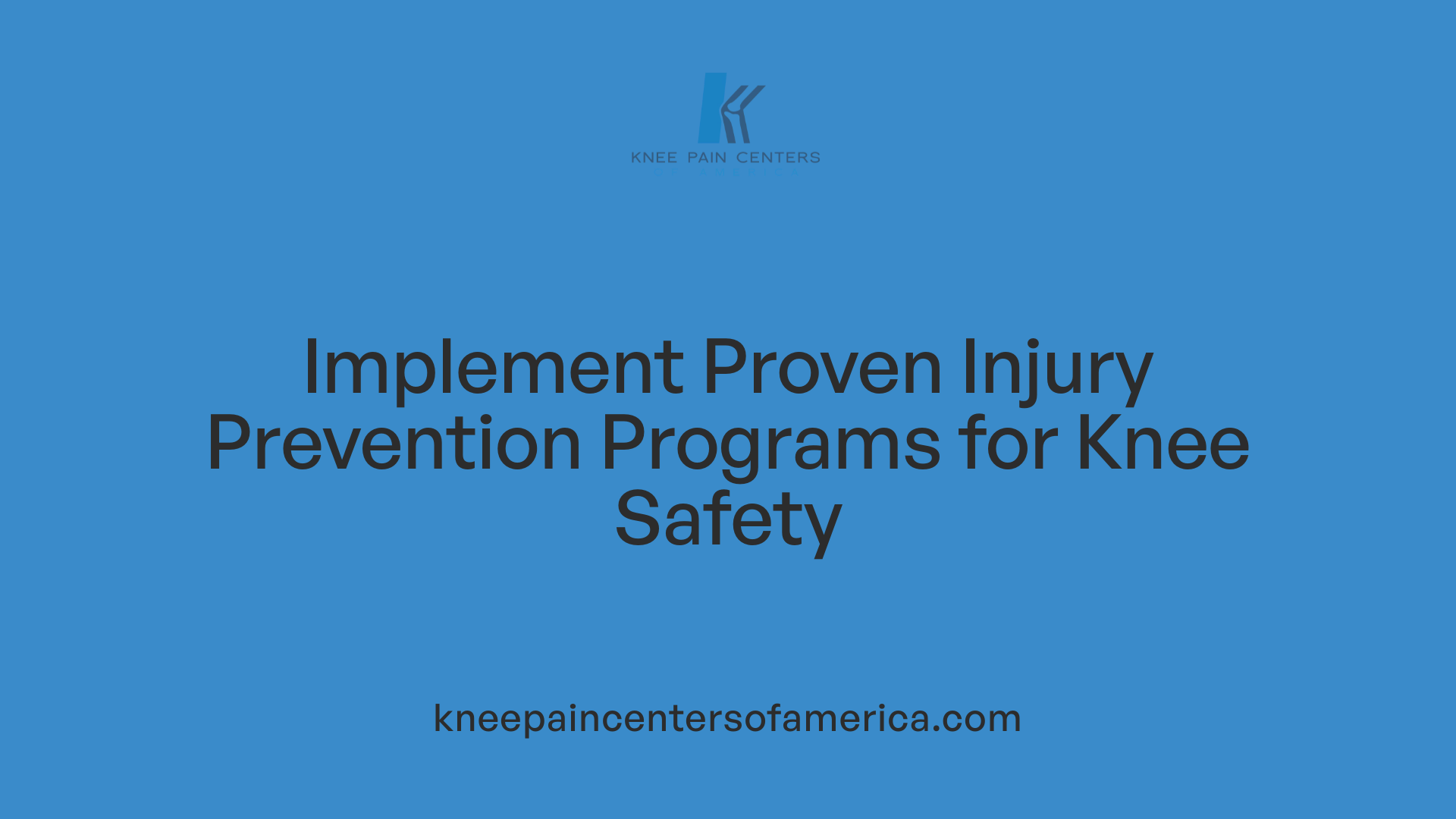Understanding and Protecting Your Knees During High-Impact Sports
Knee injuries are a common concern among athletes engaged in high-impact sports such as basketball, soccer, and volleyball. These injuries can sideline athletes for extended periods and impact long-term joint health. Prevention is key, and it involves a multifaceted approach that includes proper training, technique, equipment, and lifestyle habits. This article explores evidence-based strategies, exercises, and best practices designed to keep your knees safe and healthy during intense physical activity.
Fundamentals of Knee Anatomy and Injury Mechanisms

What is the structure and function of the knee joint?
The knee joint is one of the largest and most complex joints in the body. It connects the thigh bone (femur) to the shin bones (tibia and fibula). Its main functions include enabling movement like bending and straightening, supporting weight, and absorbing shock during activities such as running and jumping.
The knee's stability is maintained by bones, ligaments, tendons, muscles, and cartilage. Major ligaments include the anterior cruciate ligament (ACL), posterior cruciate ligament (PCL), medial collateral ligament (MCL), and lateral collateral ligament (LCL). The cartilage, particularly the menisci, cushions the bones and aids in smooth movement.
How do common injury mechanisms in sports affect the knee?
In sports, injuries often happen through sudden movements, such as pivoting, jumping, or abrupt stops. Overuse or repetitive stress can also lead to strains. Common injuries include ACL tears, meniscus injuries, and ligament sprains.
ACL injuries, for instance, often occur during rapid directional changes or improper landings. Meniscus tears are usually caused by twisting or compressing the knee under load. These injuries can result from poor technique, insufficient warm-up, fatigue, or wearing inappropriate footwear.
How understanding knee anatomy can help prevent injuries
Knowing how the knee's structures function helps athletes and clinicians develop effective prevention methods. For example, strengthening surrounding muscles like the quadriceps, hamstrings, calves, and hips stabilizes the knee. Proper warm-up routines stimulate blood flow and activate muscles, reducing strain.
Using correct movement techniques—such as landing softly with knees aligned over toes—minimizes unnecessary stress. Incorporating neuromuscular and balance exercises improves joint stability and control. Additionally, wearing suitable supportive footwear and protective gear lessens impact and prevents falls.
Education on proper training, gradual increase in activity levels, and biomechanical assessments can detect potential risk factors and address them early. Overall, targeted training combined with a solid understanding of knee anatomy significantly reduces the likelihood of injury during sports activities.
Warm-Up, Flexibility, and Proper Technique for Injury Reduction

What are the common causes and risk factors for knee injuries in athletes?
Knee injuries among athletes often occur due to various factors that increase stress on the joint. Overuse injuries result from repetitive motions such as jumping, running, or cutting, leading to strain and microtrauma. Sudden trauma, like a direct blow or awkward fall, can cause ligament tears or fractures.
Improper technique during sports activities also puts excess pressure on the knees. For example, landing wrong after a jump or cutting at incorrect angles can lead to injuries like ACL tears. Muscular imbalances, especially weak glutes, hamstrings, or quadriceps, can reduce joint stability.
Pre-existing conditions such as previous knee injuries, poor neuromuscular control, and inadequate training increase the risk. Additional factors include being overweight, which amplifies joint load, and environmental influences like hard playing surfaces.
In female athletes, wider pelvises and hormonal factors such as increased ligament laxity contribute to higher injury likelihood. Fatigue and insufficient warm-up routines further elevate risk levels.
To prevent injuries, it’s important to follow a comprehensive approach: strengthening supporting muscles, practicing correct movement techniques, and performing neuromuscular training. Regular flexibility exercises and proper footwear also play roles in reducing injury incidence.
Strengthening and Stability Exercises to Safeguard the Knee

What techniques and exercises can help minimize knee pain and avoid injury in sports?
Preventing knee injuries involves a combination of proper warm-up routines, targeted exercises, and strategic activity choices. Starting each session with dynamic stretches, such as leg swings, high knees, and walking lunges, increases blood flow and prepares muscles around the knee for activity.
Strengthening exercises play a crucial role. Exercises like squats, lunges, and Nordic hamstring curls target the quadriceps, hamstrings, and glutes, supporting the knee joint and enhancing stability. Incorporating core and hip stabilization workouts, such as planks and bridges, further helps in maintaining proper alignment and reducing undue stress on the knees.
Balance and proprioception training, including single-leg stands and balance board drills, improve neuromuscular control and joint stability, which are vital in preventing falls and improper movements during sports.
It is essential to use proper technique consistently. Keeping knees aligned with toes during exercises, avoiding sudden or jerky movements, and using appropriate supportive gear like knee braces can significantly decrease injury risk.
Additionally, maintaining a healthy weight reduces the overall load transmitted through the knee joints. Low-impact aerobic exercises like swimming and cycling help maintain cardiovascular health without overloading the knees.
Proper footwear with good support absorbs impact and promotes correct foot positioning, further protecting knee health. Proper body mechanics, including correct landing mechanics during jumps and landings, also reduce stress on the knees.
In case of pain or injury, applying RICE (Rest, Ice, Compression, Elevation) and consulting healthcare professionals promptly can prevent worsening conditions and support recovery.
Performing these injury prevention exercises during the preseason and maintaining a consistent routine throughout the sports season help keep knees strong and resilient.
Injury Prevention Programs and Their Role in Knee Safety

What injury prevention programs and training interventions are effective for athletes?
Effective programs to reduce the risk of knee injuries leverage a mix of neuromuscular training, strength exercises, and flexibility routines. One renowned approach is the FIFA 11+ program, which consists of dynamic stretches, running drills, strength training, and plyometric exercises. This comprehensive warm-up is designed not just to prepare athletes physically but also to educate them on proper biomechanical techniques.
Scientific studies consistently show that such programs can cut injury rates by up to 60% for ACL tears and 70% for other lower limb injuries. These programs are most effective when performed multiple times weekly, ideally lasting at least 20 minutes per session, accumulating a minimum of 30 minutes weekly. They should be implemented during preseason and maintained throughout the competitive season.
Special emphasis is placed on exercises targeting the quadriceps, hamstrings, hips, calves, and core. Examples include lunges, Nordic hamstring curls, planks, bridges, and sport-specific drills. Incorporating balance and proprioception training, such as single-leg stands and balance board exercises, bolsters neuromuscular control — crucial for stable joint function.
Training interventions are complemented by the use of tools to monitor fatigue levels, like Rate of Perceived Exertion (RPE), helping prevent overtraining and injuries. Education from coaches, trainers, and healthcare professionals enhances adherence, ensuring that athletes perform exercises correctly and consistently.
How often, how long, and when should injury prevention exercises be performed?
Research indicates that engaging in injury prevention exercises 4 to 5 times weekly yields the best results. Each session should last around 20 minutes, contributing to a weekly total of at least 30 minutes. Starting these programs during preseason is vital for establishing proper movement patterns, and continuous practice is necessary throughout the season to adapt and maintain joint stability.
Long-term commitment, with programs extending over 26 weeks, leads to more significant risk reductions. Consistency ensures that neuromuscular adaptations are retained, and athletes maintain optimal function.
The role of coaches and healthcare professionals in program adherence
Support from coaches, athletic trainers, and healthcare providers is critical for successful injury prevention. They help educate athletes on proper warm-up routines, correct exercise form, and equipment use. Regular biomechanical assessments and video analyses can identify faulty movement patterns that increase injury risk, allowing for individualized corrective strategies.
Additionally, professionals can monitor progress, modify programs as needed, and motivate athletes to adhere consistently to injury prevention routines. This collaborative approach fosters a culture of safety and awareness, substantially reducing the likelihood of knee injuries among athletes.
| Program Type | Frequency | Duration per Session | Total Weekly Duration | Focus Area |
|---|---|---|---|---|
| FIFA 11+ | 2–3 times/week | 20 minutes | ≥ 30 minutes | Dynamic stretches, strength, plyometrics |
| ACL Prevention Program | 2–3 times/week | 20 minutes | ≥ 30 minutes | Neuromuscular control, balance, strength |
| Core & Stabilization | 3–4 times/week | 15–20 minutes | 45–80 minutes/week | Core strength, proprioception, functional drills |
Effective knee injury prevention is a long-term effort that combines scientifically supported exercises, professional guidance, and consistent practice, all aimed at maintaining joint health and athlete safety.
Maintaining Long-term Knee Health on and off the Field
Preventing knee injuries during high-impact sports requires an integrated approach that combines proper training, technique, equipment, and lifestyle habits. Incorporating evidence-based prevention programs, strengthening surrounding muscles, optimizing flexibility, and following professional guidelines can substantially reduce injury risk. Regular consultation with sports medicine professionals, adherence to structured warm-up and cool-down routines, and listening to one’s body are vital steps in safeguarding knee health. By adopting these practices consistently, athletes can enjoy high performance while minimizing the likelihood of knee injuries, ensuring longevity and joint vitality for years to come.
References
- Preventing Knee Injuries During High-Impact Sports - Witchita, KS
- Preventing Knee Injuries in Sports | Aligned Orthopedic Partners
- [PDF] Knee Injury Prevention: Exercises to Keep You From Getting Sidelined
- Your Guide to Knee Injury Prevention in Sports
- Preventing Knee Injuries: Exercises to Keep You From Getting ...
- Essential Guide to Preventative Care for Knee Injuries: Stay Active ...
- How to Prevent an ACL Injury in Young Athletes
- The effects of training intervention on the prevention of knee joint ...
- How Female Athletes Can Prevent Knee Injury
- Sports Medicine: Quick Tips to Help You Avoid Knee Injuries





